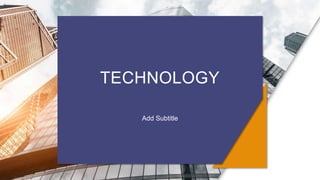Technology
- 2. WHAT IS TECHNOLOGY? Technology is the sum of techniques, skill s, methods, and processes use d in the production of goods or service s or in the accomplishment of2
- 3. âĒ Artificial Intelligence âĒ Robotics âĒ Information Technology âĒ Consumer Technology âĒ Virtual Reality 5 PARTS OF TECHNOLOGY 3
- 5. WHAT IS ARTIFICIAL INTELLIGENCE?Artificial intelligence (AI) is wide-ranging branch of computer science concerned with building smart machines capable of performing tasks that typically require human intelligence. AI is an interdisciplinary science with multiple approaches, but advancements in machine learning and deep learning are creating a paradigm shift in virtually every sector of the tech industry. 5
- 6. HOW IS ARTIFICIAL INTELLIGENCE APPLIED? Popular misconceptions tend to place AI on an island with robots and self-driving cars. However, this approach fails to recognize artificial intelligenceâs major practical application; processing the vast amounts of data generated daily. 1 By strategically applying AI to certain processes, insight gathering and task automation occur at an otherwise unimaginable rate and scale.2 6 Parsing through the mountains of data created by humans, AI systems perform intelligent searches, interpreting both text and images to discover patterns in complex data, and then act on those learning's.3
- 7. âTHE LEAST SCARY FUTURE I CAN THINK OF IS ONE WHERE WE HAVE AT LEAST DEMOCRATIZED AIâĶ[ALSO] WHEN THEREâS AN EVIL DICTATOR, THAT HUMAN IS GOING TO DIE. BUT FOR AN AI, THERE WOULD BE NO DEATH. IT WOULD LIVE FOREVER. AND THEN YOUâD HAVE AN IMMORTAL DICTATOR FROM WHICH WE CAN NEVER ESCAPE.â - ELON MUSK
- 8. ROBOTICS
- 9. WHAT IS ROBOTICSRobotics is the intersection of science, engineering and technology that produces machines, called robots, that substitute for (or replicate) human actions. Robotics involves design, construction, operation, and use of robots. The goal of robotics is to design intelligent machines that can help and assist humans in their day-to-day lives and keep everyone safe. 9
- 10. FUTURE IN ROBOTICS In future robots will become security guards and aid police officers, without needing to fund intensive training. They will have mod cons like infrared eyes making it 10x easier when chasing criminals in pursuit, a real life robocop. 1 A report says that by 2030 one third jobs could be automated. Robotic engineers are designing the next generation of robots to look, feel and act more human, to make it easier for us to warm up to a cold machine. Realistic looking hair and skin with embedded sensors will allow robots to react naturally in their environment 2 10 Even there will be pets in the form of robots and you will not feel any difference between a real one and a robot. 3
- 12. WHAT IS INFORMATION TECHNOLOGY Information technology (IT) is the use of computers to store, retrieve, transmit, and manipulate data or information. IT is typically used within the context of business operations as opposed to personal or entertainment technologies. IT is considered to be a subset of information and communications technology (ICT). An information technology system (IT system) is generally an information system, a communications system or, more specifically speaking, a computer system â including all hardware, software and peripheral equipment â operated by a limited group of users.12
- 13. INFORMATION TECHNOLOGY USES IN DAY TO DAY LIFE Information technology is used in every sphere of life like education, communication, business, commerce, treatment and banking etc. Businesses are investing heavily into new technological trends as well as offering businesses the chance to operate more effectively through the application of information technology. 1 Letâs look at the example of communication as it has definitely changed the way of our daily life. Many years ago we used to communicate via writing but now we communicate by using information network like telephone, mobile phone, internet etc. 2 13 IT has changed tremendously over the years especially in the computing field. Nowadays, more or less every household has an iPod or computer or some Apple related product. We know have cloud computing, as well as Virtual servers. Long have the days of needing your own server to run things. You can now involve in online outsourcing. Staying in the east you can work in the west and earn a large amount of dollar. 3
- 15. WHAT IS CONSUMER TECHNOLOGY Consumer technology is any technology that is directly purchased by individuals to meet their needs. This differs from enterprise technology that is used by governments, organizations and businesses to achieve objectives. Examples of Consumer Technology: âĒ Computing. Computers and related software and hardware. âĒ Networking. Tools for connecting to networks. âĒ Data. Data storage and management including both physical devices and services. . 15
- 16. VIRTUAL REALITY
- 17. WHAT IS VIRTUAL REALITYVirtual reality (VR) is a simulated experience that can be similar to or completely different from the real world. Applications of virtual reality can include entertainment (i.e. video games) and educational purposes (i.e. medical or military training). Other, distinct types of VR style technology include augmented reality and mixed reality, sometimes referred to as extended reality or XR.. 17






![âTHE LEAST SCARY
FUTURE I CAN THINK OF
IS ONE WHERE WE HAVE
AT LEAST DEMOCRATIZED
AIâĶ[ALSO] WHEN THEREâS
AN EVIL DICTATOR, THAT
HUMAN IS GOING TO DIE.
BUT FOR AN AI, THERE
WOULD BE NO DEATH. IT
WOULD LIVE FOREVER.
AND THEN YOUâD HAVE AN
IMMORTAL DICTATOR
FROM WHICH WE CAN
NEVER ESCAPE.â
- ELON MUSK](https://image.slidesharecdn.com/csppt-201124114254/85/Technology-7-320.jpg)










